Family : Charadriidae

Text © Dr. Gianfranco Colombo

English translation by Mario Beltramini
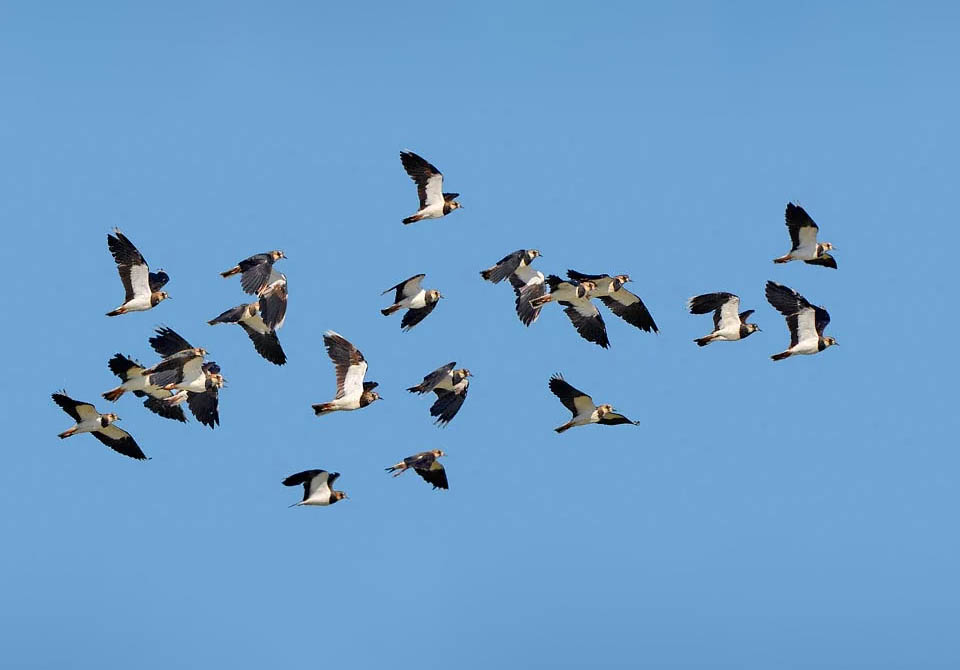
The Lapwing is a limicolous migrant very common in Eurasia. The flocks do not go unnoticed and indicate, some time in advance, the forthcoming change of seasons © Gianfranco Colombo
The Lapwing or Northern lapwing or Peewit or Green plover (Vanellus vanellus Linnaeus, 1758), belongs to the order of the Charadriiformes and to the family of Charadriidae.
Very common and familiar bird in Europe where has become, for the agricultural world, an indicator of the arrival, alternatively, of the good or the bad weather. In the Netherlands since centuries has remained alive the popular tradition to carry to the Queen the first egg of lapwing found in the countries with a quite clear message: the arrival of spring and of the good weather.
From the collection of these news it has been then understood that the date was each time more anticipated thus giving indirectly a clear information about the influence of the climate change in progress because the global waming.
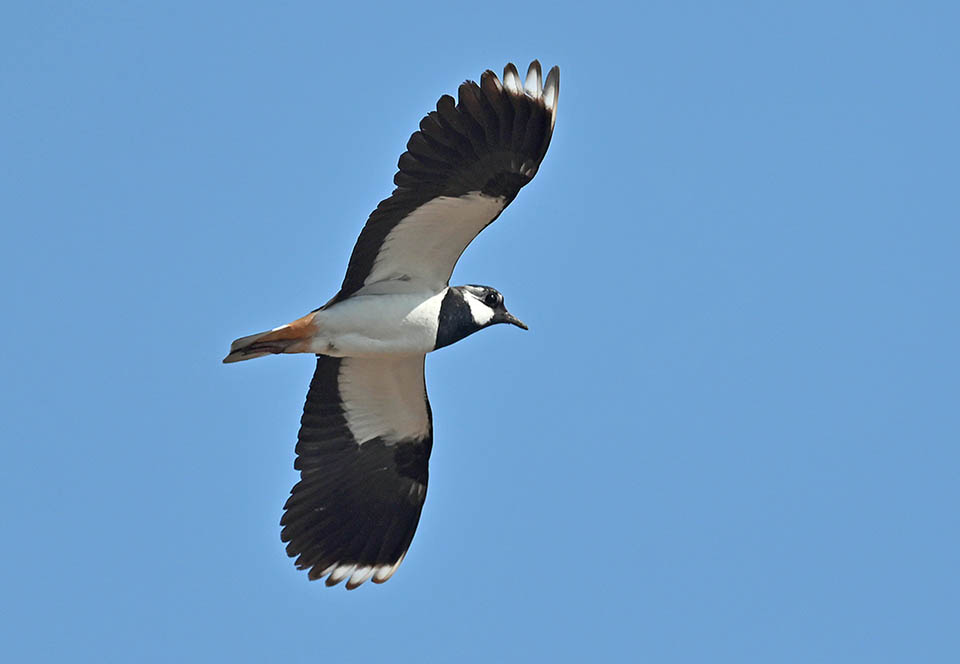
It is a Charadriidae of medium size with a weight that may reach the 300 g, with a wingspan of about 80 cm and a length of 30 © Gianfranco Colombo
Still in Victorian England, but at that time also in all Europe, its was the custom of collecting these eggs for preparing cakes and tasty pastries and this aliment was considered as an expensive delicacy.
In some European areas where converge for wintering huge flocks of these birds, the arrival is considered, conversely, as an anticipation of cold spells or of the bad weather. The lapwing is a bird that does not go unnoticed because it moves always in flocks, huge at time, and therefore draws the curiosity of anyone coming across their passage.
Furthermore, the contrast of their livery, dark above and white below, seen from far away and accentuated by the typical dancing flight, leaves to appear alternately the white and the back like some sudden lightnings.
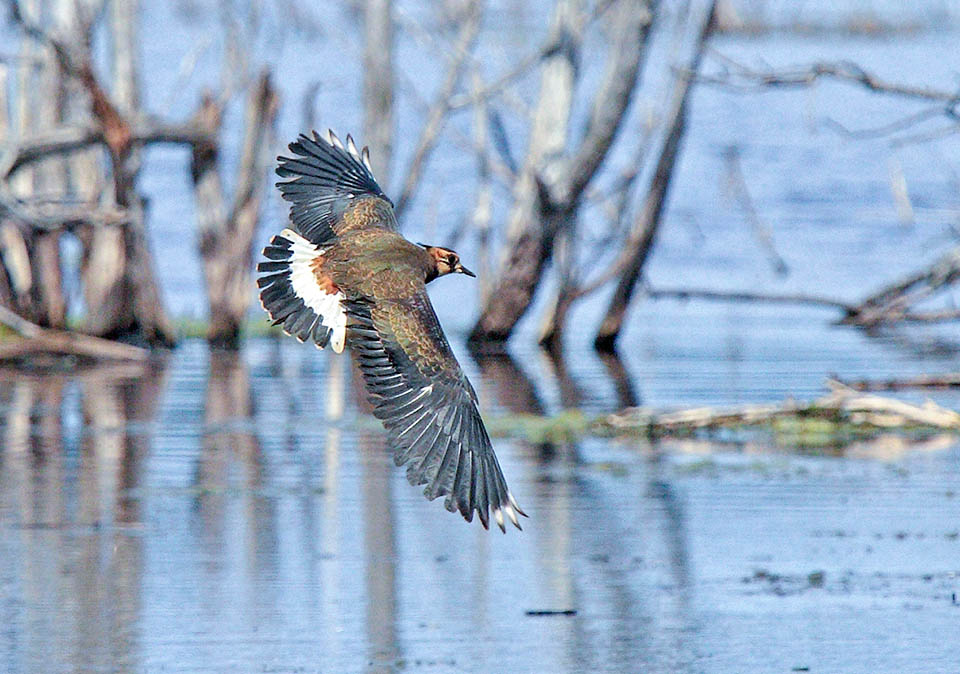
The Lapwing is a bird linked to water and to the wet soils, even if it often spends a good part of its time in environments where this element is not present © Татьяна Высоцкая
Also when on the ground on the bare winter soils it does not go unnoticed seen the always numerous number and the erect and elegant posture of its gait.
The common names give to such a common bird in the countries of all Europe, are manifold. In England it is called Lapwing, due to the odd pirouettes and evolutions it performs while flying over its territory and also due to the noise of the soundly beaten wings or also Peewit as imitation of its usual call and also Green Plover due to its greenish colour. In Italy it is called pavoncella due to the bluish green reflection of the livery similar to that of the peacock. In Spain Avefrìa Europea with clear reference to “Aves”=bird and “fria”= cold. In Dutch and in German, respectively Kievit and Kiebitz, an onomatopoeic reference to its singing. In France Vanneau huppé due to the evident tuft it elegantly carries on the head.
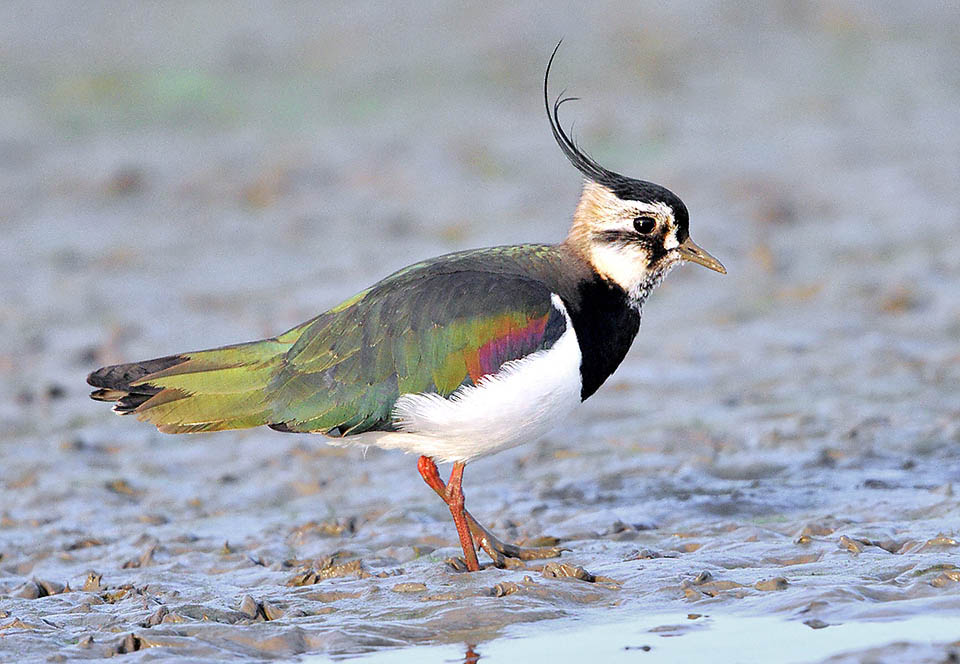
Main characteristic, besides the elegant livery more accentuated in males, is the presence of a cheerful and long tuft that waves easily in the wind © Gianfranco Colombo
The scientific name Vanellus comes from the Latin “vannus” = the fan for sieving the wheat, to indicate the resemblance between the sound of the beating of its wing to the wheezing noise of the wheat when solicited by the wheat sieve.
Zoogeography
Vanellus vanellus is present all over Europe, Scandinavian Peninsula and European Russia included. Beyond the Urals it occupies the cold temperate belt through the vast prairies of central Asia to reach the coast of the Pacific Ocean and the Japan. Being a migratory species, the populations of the extreme North-Europe get down to lower latitudes during the winter occupying the south of Europe and occasionally the western North Africa.
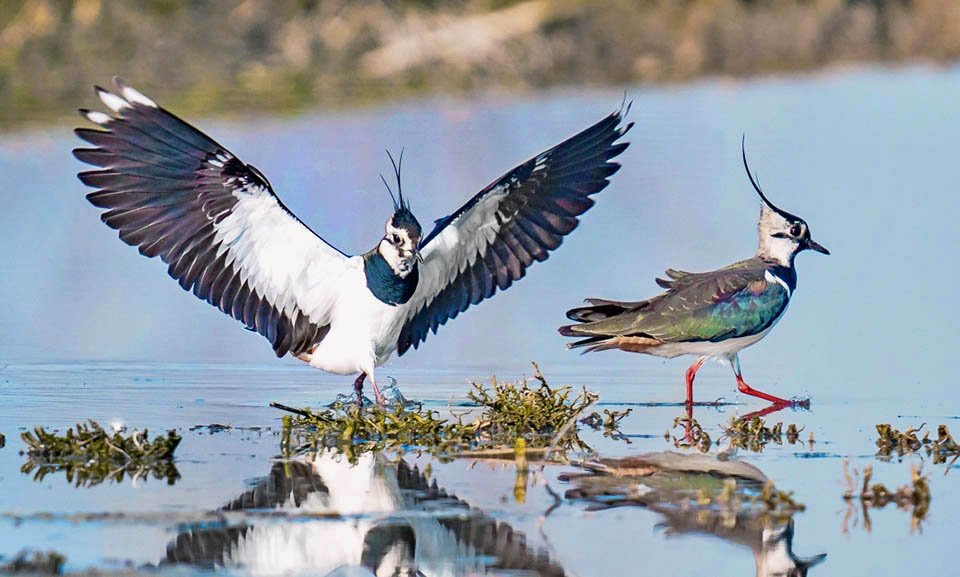
In breeding season males are nervous. They often open the large wings on the ground to get noticed and attack rivals © Marco Anfossi
The Asian populations, on the contrary, migrate mainly in China and partially in the Indus Valley in Pakistan and in the valleys of the northern part of India.
The migration of this bird has often directions contrary to the usual winter routes followed by the migrants for escaping the harsh winter. As a matter of fact, part of the Dutch, French and Belgian populations and also from other central European areas move towards England to spend there the bad season. These off course movements are also characteristics of the year juveniles that often gather in summer groups and go strolling along the European plains and at times even further afield, whether located to the south or north of their native territories.
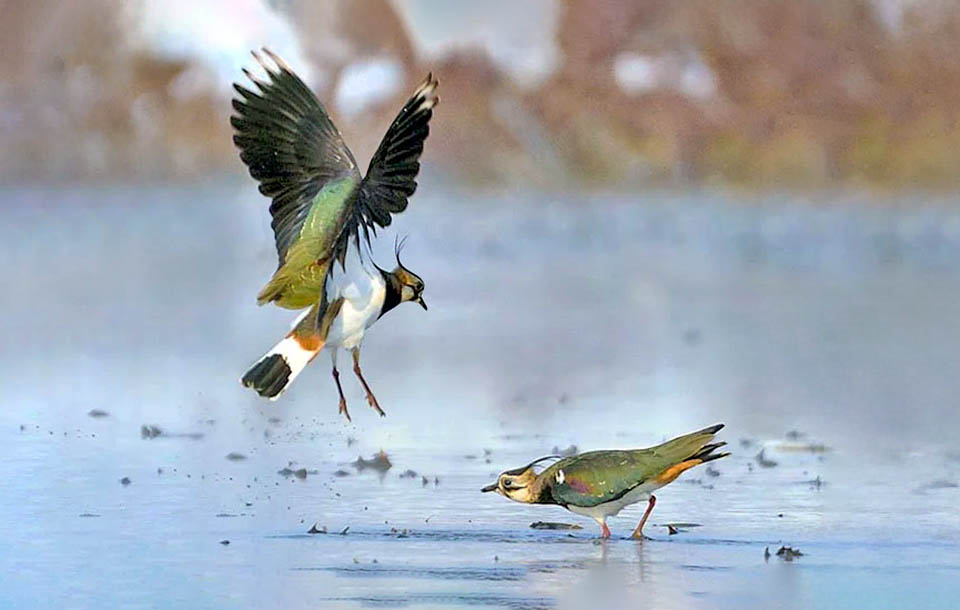
Skirmishes on the ground with reckless leaps and parades are quite frequent © Gianfranco Colombo
Ecology-Habitat
Vanellus vanellus is a wader bird linked to the water and the humid lands, even if often spends a good part of its time in locations lacking of this element. However, and inevitably, during the day it must have a contact with the water. A Lombard saying recites that the lapwing must wash its feet every evening.
It frequents cultivated territories especially in the plains where it finds, in particular thanks to the advent of monoculture, a habitat very suitable for the nidification.
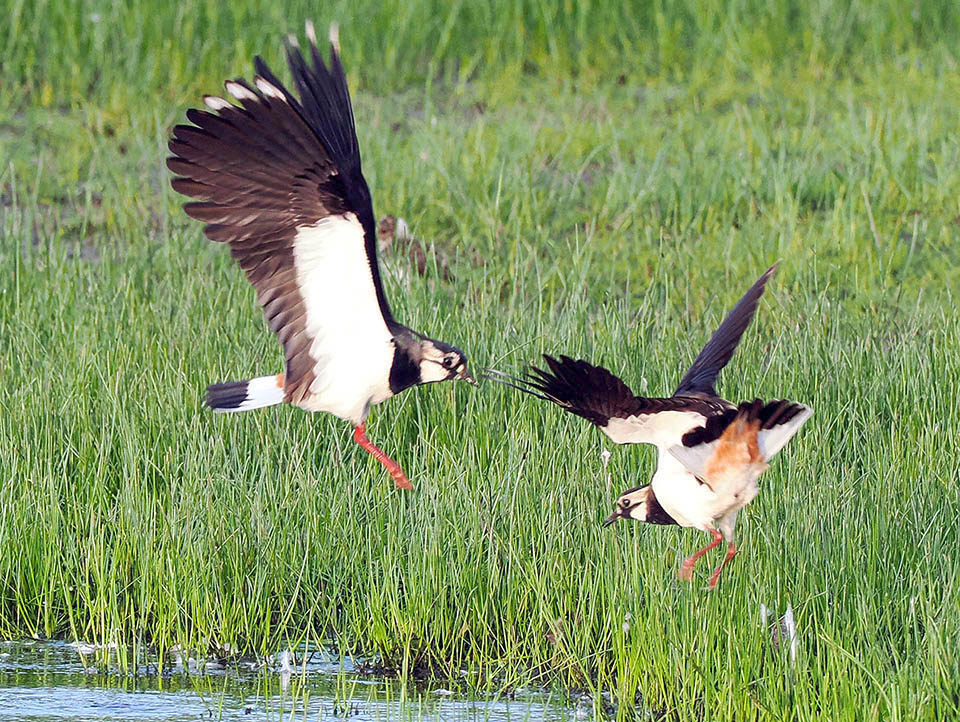
But they often argue even in flight while the females stand by and watch © Jakob Fahr
Although it loves meadows and grassy locations, it seems that due to the increase of the plowed fields for sowing of maize or soy, these sites have become recently their choice place for nidifying.
Unfortunately, the various operations done for preparing the cultivations are also the main cause of the destruction of a good number of nests. Plowing, harrowing, crushing of clods, sowing, levelling and the various phases for the weeding, are operations done during various weeks and inevitably the nests already prepared in the mean time are irretrievably destroyed. The lapwing has however a fast reaction to these incidents and if the occurrence takes place during the first times of the spawning, it is immediately ready to redo a new brood.
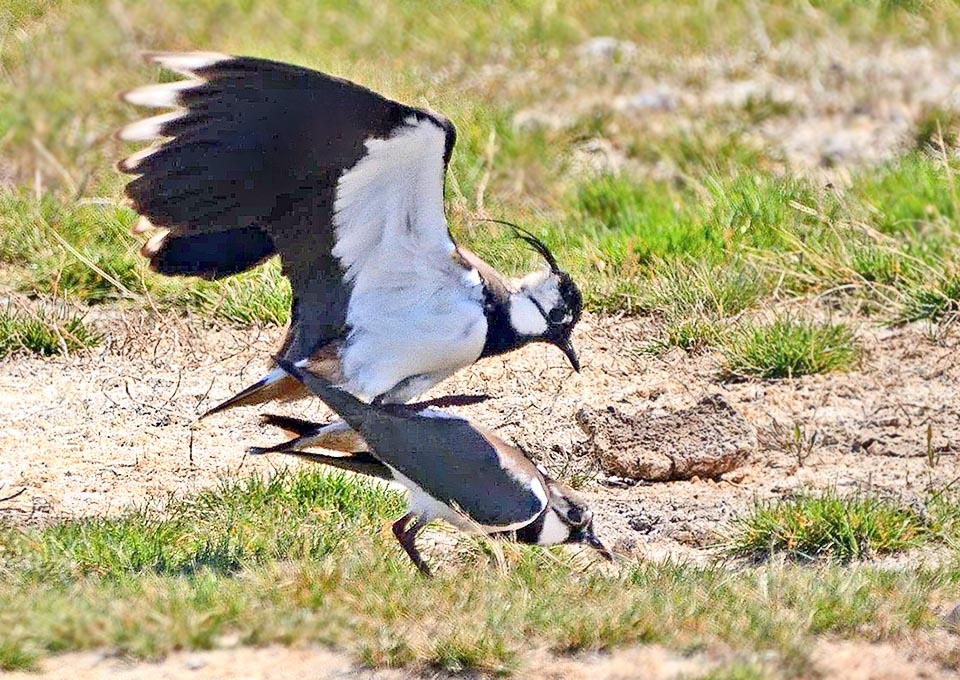
At the end, the discouraged rival goes away and the mating takes place © Dmitry Shtol
This bird is the regular visitor to the plains and hardly moves in mountain or even simply hilly sites. It does not frequent treed areas nor shrubby ones but needs totally clear spaces and without high vegetation.
During the transit, it is found also in the abandoned fields, in the stubbles, in the few remaining water meadows and in the rice fields, in the last ones only for making use of the little water that accumulates during the winter rains.
And it is also quite ready to move for large distances when the ground is covered by sudden snowfalls or when the temperature goes down to very low levels for various days, icing and hardening the ground hopelessly.
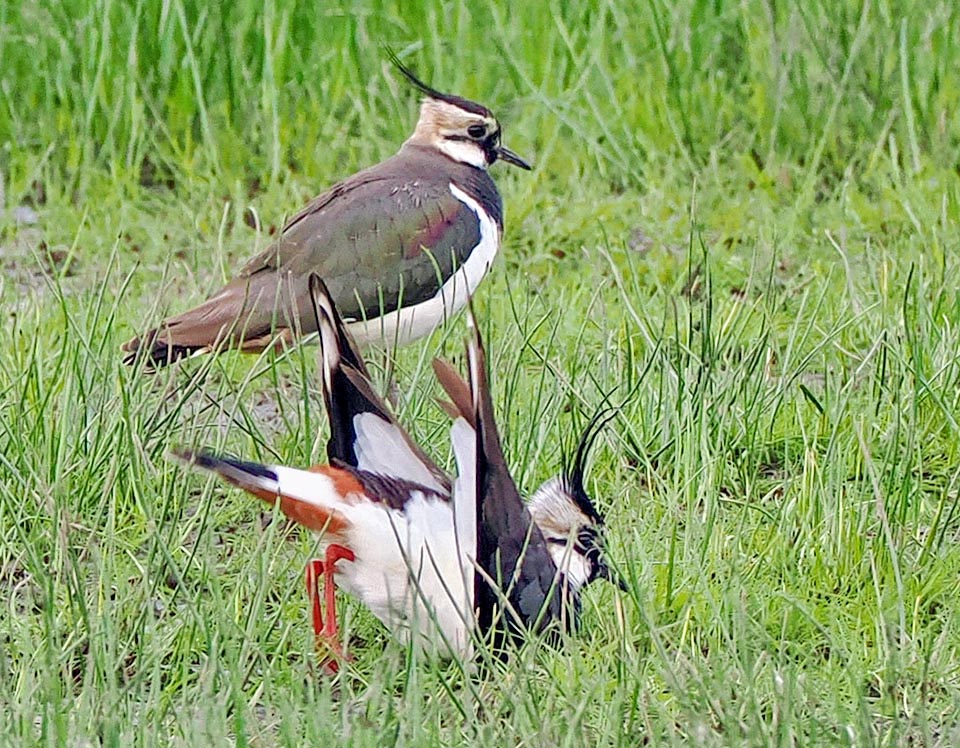
With this weird position the males show to the female the location where to build the nest and to lay © Jakob Fahr
It is so that at times it is met even on the north African coasts.
As we said before, this bird appears to be able to foresee with a certain margin of time the climate changes under way. Often observers have witnessed a sudden, unmotivated and total disappearance of huge flocks from permanently frequented areas during the wintering with the fall of a heavy snowfall a few hours later.
Vanellus vanellus has a typical way for hunting the earthworms, their choice prey.
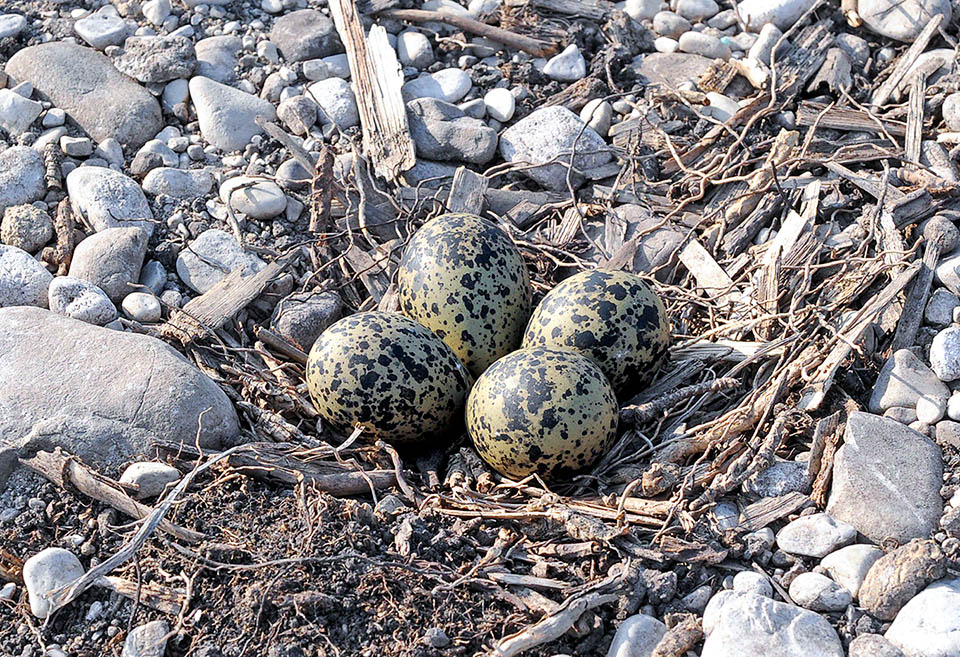
Four eggs are usually laid into a depression of the ground, dug by the male and decorated by the female, © Gianfranco Colombo
The long paws and the typical runner fingers, allow them to move and sift the ground tirelessly where they look for they preys. This does not mean that their victims are not well hidden under some centimeters of land and are not visible from the surface.
But the lapwing has devised an exceptional system for finding them and getting them out from the underground autonomously.
It is known that the main foe of the earthworms is the mole and it is well known that this animal while digging produces a slight vibration of the ground that, alarming the earthworm, obliges it to surface immediately in order to elude capture.
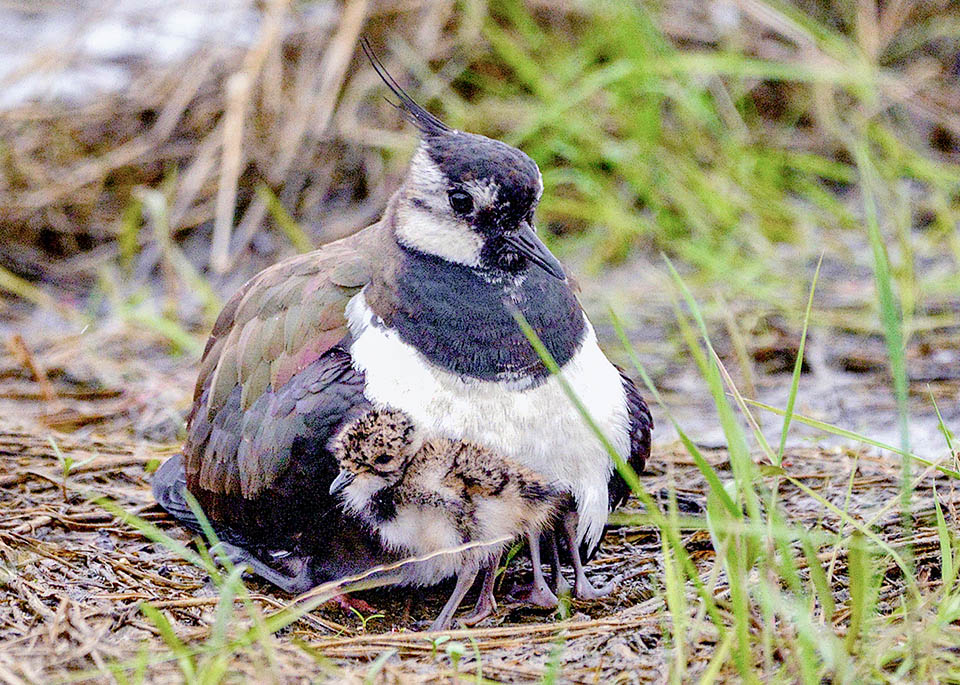
The hatching lasts 4 weeks and the chicks, nidifugous, leave the nest just a few hours after the birth © Андреенков Олег Владимирович
As a matter of fact, the lapwing takes advantage from this characteristic wonderfully and intelligently. It lightly presses a foot on the ground and moves it gently causing a light vibration which is felt by the underlying earthworm and obliges it to get to the surface.
As usual for plovers, also the lapwings love to feed during the night especially in the moonlighted evenings.
During the migrations, this bird if often observed sharing the feeding areas with the Golden plovers (Pluvialis apricaria), Ruffs (Philomachus pugnax) and other waders but also Black-headed gulls (Chroicocephalus ridibundus) birds very proficient at stealing them the caught preys.
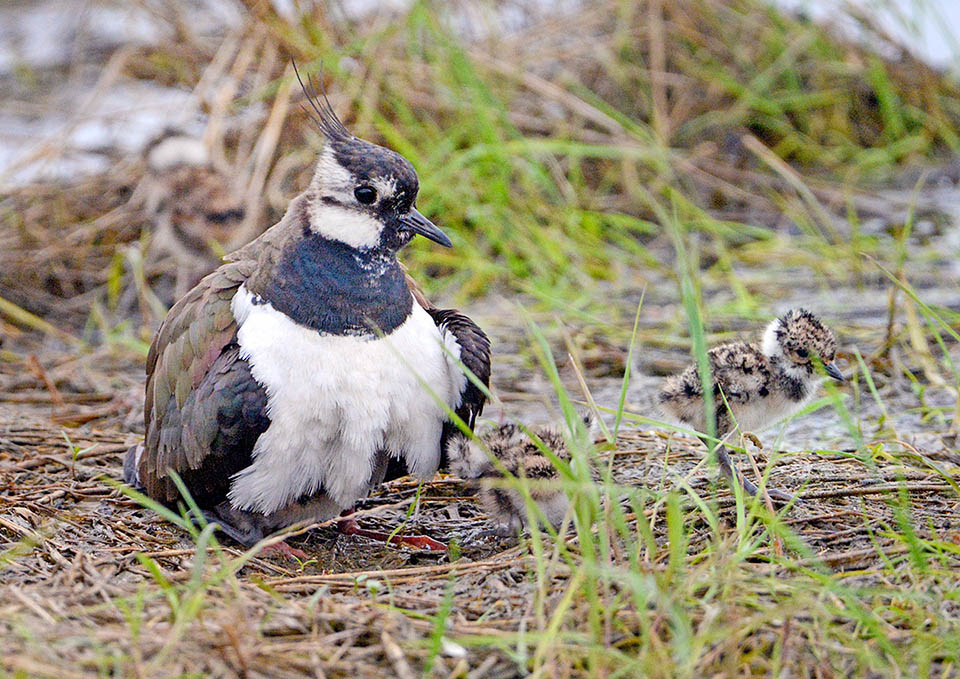
Female is an excellent brooder and tries to hold them, shielding them under the body, but one after the other they go away © Андреенков Олег Владимирович
The lapwing eats also insects, especially cockroaches, grasshoppers, butterflies and dragon flies but does not disdain spiders and also seeds of various grasses.
Morpho-physiology
It is a medium-sized charadriid with a weight that may reach the 300 g, a wingspan of about 80 cm and a length of 30. The livery shows the black bronze with greenish and auburn reflections upper part, much more pronounced in the male and candid white chest crossed by a black collar encircling the throat.
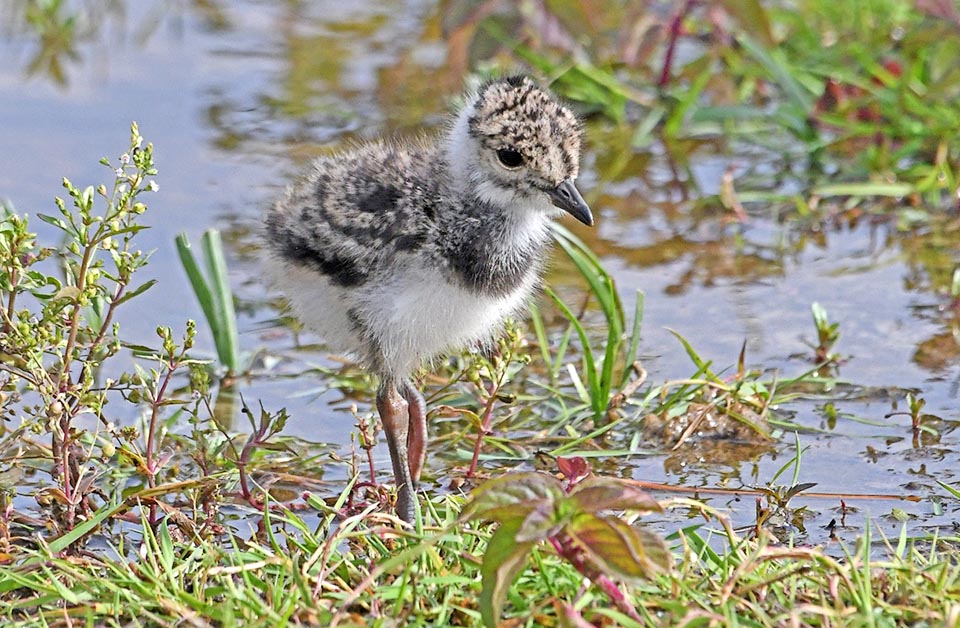
It’s already autonomous few days after birth and nimbly moves in search of food © petroeska
Main characteristic of this wader is the presence of a cheerful and long tuft that waves easily at the slightest breath of wind. Few black feathers, streamlined, even 10 cm long that bears elegantly and that give a touch of finesse to its livery. The tail is white with a wide black terminal belt, in neat contrast to the light brown undertail this bird displays in the courting phase. The wings are roundish and slightly arched. The underwing evidences black remiges and candid coverts.
The eyes are black, very round and large, suitable also for a night life and the eyesight is very sharp allowing to keep under strict control the vast environment it frequents. The paws are greenish, robust, well suitable for running.
In winter, when the sexes are practically in distinguishable, the only detectable dimorphism is confined to the reading of the first and fourth primary remige that shows white shades and spots in various positions.
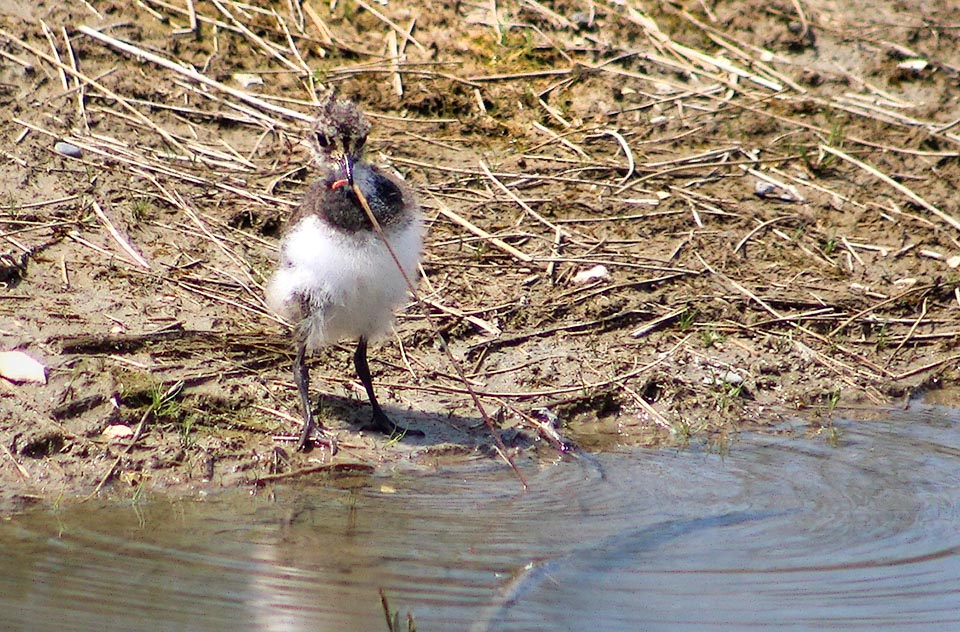
This, looking at adults, has already learnt how to catch the earthworms present along the banks © Benjamin Mayer
Ethology-Reproductive Biology
The nest of Vanellus vanellus is placed on the bare ground sometimes in an absolutely barren area and without any presence of vegetation. The nest is an extremely simple and shallow depression in the ground usually dug by the male and completed by the female.
During the mating season, it is not difficult to observe the males digging these numerous depressions showing and spreading the light brown undertail to attract the female that, once chosen the hole, will complete the work. Interspersed, then there are the endless aerial acrobatics over the chosen territory that see the males making ascensions, nose-dives, volplanes and sudden tail downs while emitting their mournful singing and beating the wings noisily.
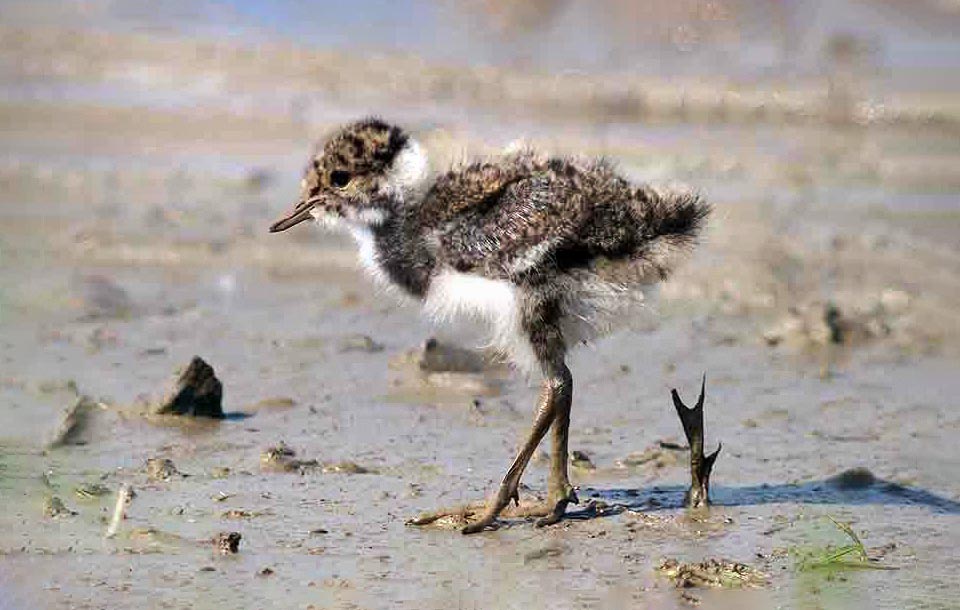
It will also learn to clap its paws on the ground simulating the noise of the moles to get little worms out into the open © Luigi Andena
The nest is adorned with quite a little material in order to render it as much as possible invisible to possible foes from the air, usually pieces of vegetation found on the same spot and at times some little stone. Also the eggs have a colour easy to be mistaken with the soil and often get dirty of the same colour of the ground where they lay. The eggs are greenish more or less highly spotted by wide black patches and are laid with a daily frequency. It usually lays 4 eggs and the hatching begins simultaneously to the deposition of the last egg.
The lapwing is a diligent brooder and never leaves the nest during the hatching if not for the relief from the partner or for a short stretching of the legs and for a brief feeding. It nidifies in scattered colonies, with nests placed some tens of meters away each other and such to enable to share the defense against their typical aggressors.
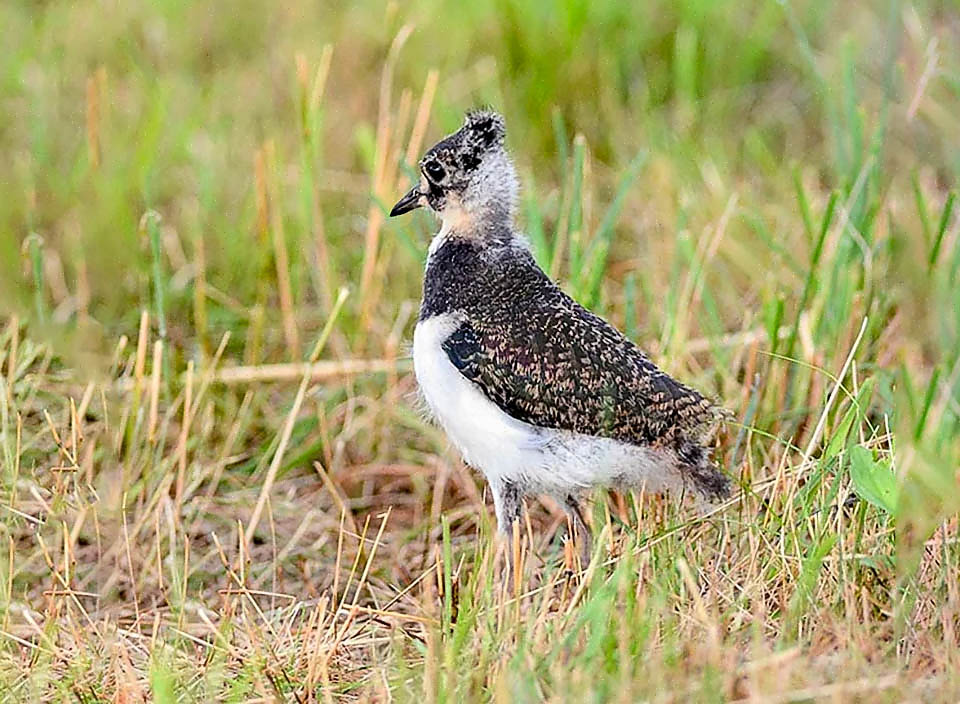
They grow rapidly and take flight 5 weeks after hatching, when they have already reached the size of their parents © Gianfranco Colombo
The hooded crow (Corvus cornix) is in absolute its main foe but also the seagulls and the fox (Vulpes vulpes), side earth, are just as deadly. The defense is common and all the couples intervene loudly with nose-dives and disturbance evolutions to annoy the aggressor.
Also the grazing cattle may be considered as an unaware aggressor but usually sheep and livestock are easily frightened and moved away but these evolutions.
The hatching lasts 4 weeks and the chicks are nidifugous and leave the nest after a very few hors from the birth. The chicks keep scattered in the native area for 5 weeks more till when they are independent and suitable to flight.
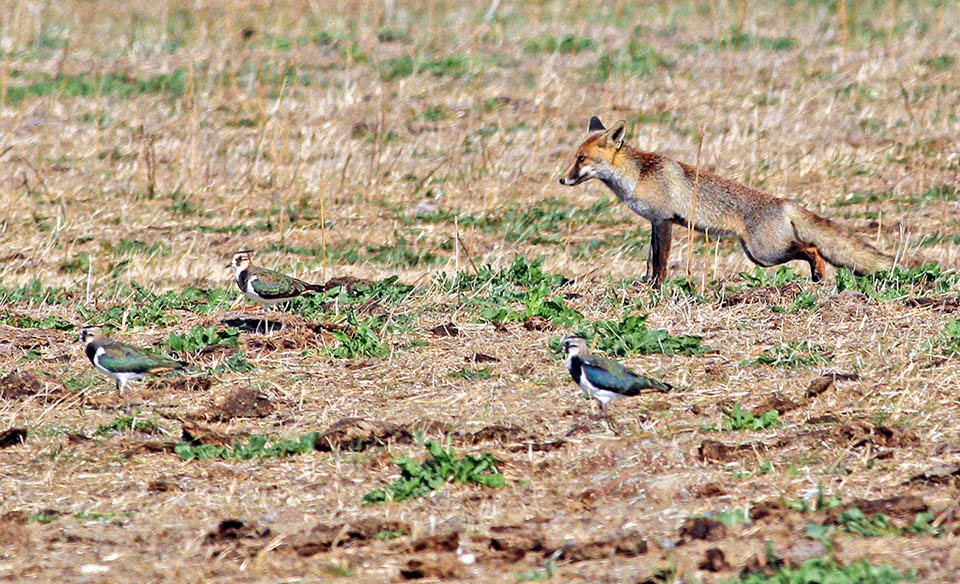
The Lapwing has many foes and, not mentioning the hunters, besides the raptors and the Grey crow, also some foxes may add © Rui Morgado
Their camouflage is remarkable and when lying among the low vegetation or even on the bare ground they are almost invisible. The fly off takes place when they reach the adults size.
Vanellus vanellus has met a strong decrease during the last decades although an expansion of its breeding range has been observed with the conquest of territories previously frequented only during the wintering period. For this reason, in the IUCN Red List of endangered species, it appears since 2017 as “NT, Near Threatened“.
Synonyms
Tringa vanellus Linnaeus, 1758.
→ For general information about the Charadriiformes please click here.
→ To appreciate the biodiversity within the CHARADRIIFORMES please click here.
